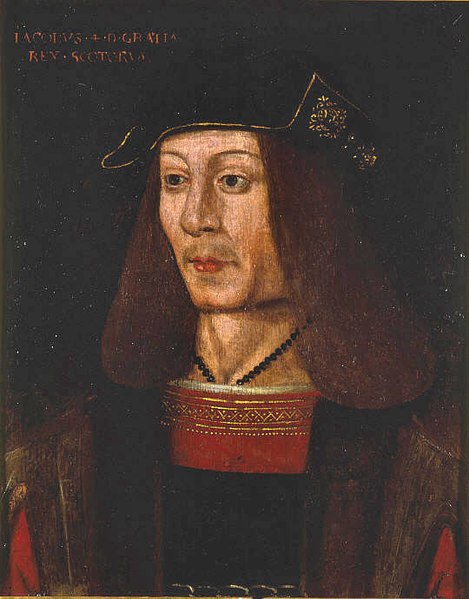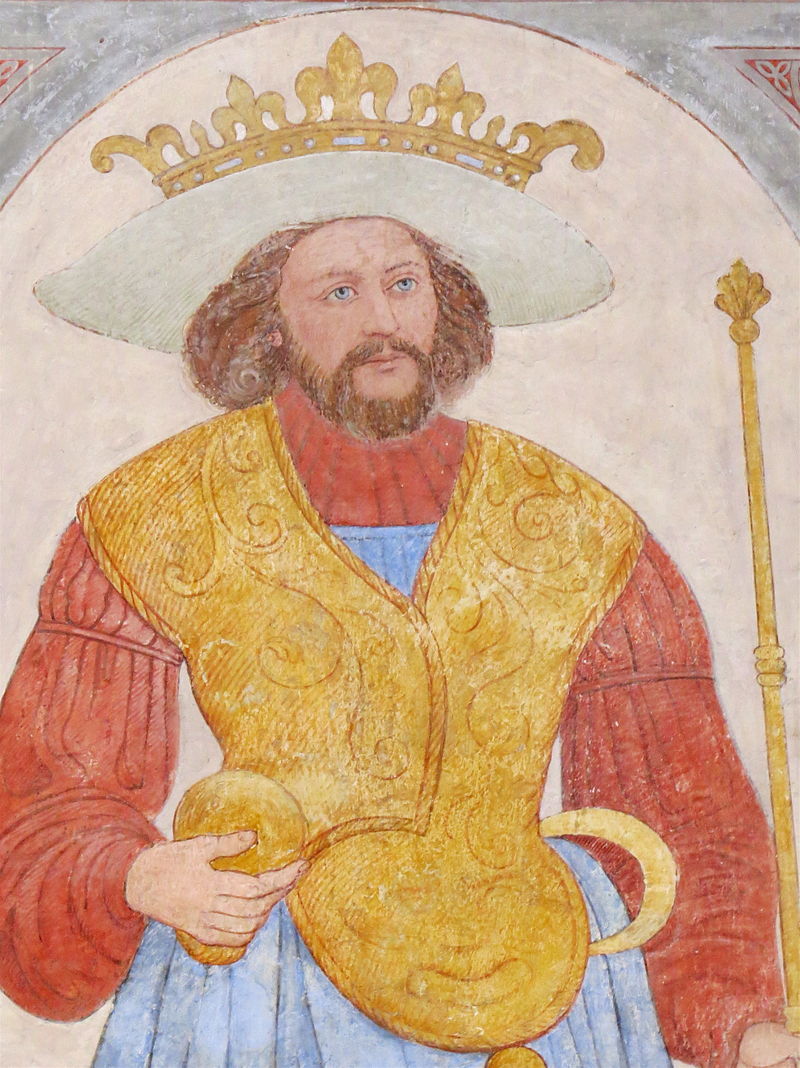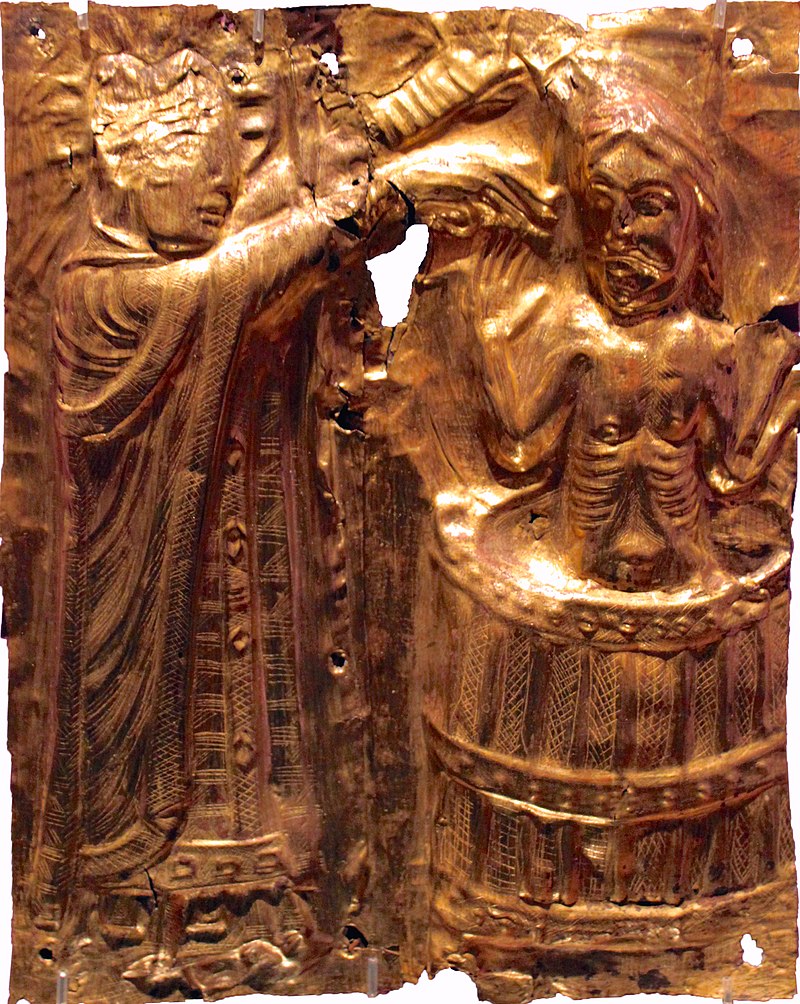© Unofficial Royalty 2025

Josephine of Leuchtenberg, Queen of Sweden wearing the Cameo Tiara she brought into the Swedish royal family; Credit – Wikipedia
March 14, 1647 – Death of Frederik Hendrik, Prince of Orange in The Hague, Holland, Dutch Republic, now in the Netherlands; buried in the royal vault at the Nieuwe Kerk in Delft, the Netherlands
Frederik Hendrik was the only child of Willem I (the Silent), Prince of Orange and his fourth wife, French Huguenot Louise de Coligny. Louise’s father, Gaspard II de Coligny, was a French nobleman and admiral but is best remembered as a leader of the Huguenots (French Calvinist Protestants). He was killed during the St. Bartholomew’s Day Massacre in 1572 when thousands of Huguenots were murdered. In 1625, Frederik Hendrik became Prince of Orange upon the death of his elder half-brother Maurits, Prince of Orange. That same year Frederik Hendrik married Princess Amalia of Solms-Braunfels. They had nine children including Willem II, Prince of Orange who married Mary, Princess Royal, eldest daughter of King Charles I of England. Their one child was Willem III, Prince of Orange, later King William III of England. Frederik Hendrik ruled the Dutch Republic for 22 years. His reign is included in the era known as the Dutch Golden Age in which Dutch trade, science, military, and art were among the most acclaimed in the world. For many years before his death, Frederik Hendrik suffered from gout. In the summer of 1646, he had a stroke that temporarily prevented him from speaking. After that, Frederik Hendrik was physically weak, difficult to cope with, and sometimes mentally unstable. He died on March 14, 1647, in The Hague, Holland, Dutch Republic at the age of 63.
Unofficial Royalty: Frederik Hendrik Prince of Orange
March 14, 1743 – Death of Catherine Darnley, illegitimate daughter of King James II of England and his mistress Catherine Sedley, Countess of Dorchester (in her own right), in London, England; buried in the Henry VII Chapel at Westminster Abbey in London, England
In 1706, Catherine became the third wife of John Sheffield, 1st Duke of Buckingham and Normanby, who was thirty-three years older than Catherine. They had three sons but sadly, they all died young. Buckingham House, a large townhouse in London, was built by Catherine’s husband John Sheffield, 1st Duke of Buckingham. The core of today’s Buckingham Palace is Buckingham House. Catherine died on March 14, 1743, aged about sixty-two, in London, England, and was buried in a vault with her second husband and their three children in the northeastern chapel of the Henry VII Chapel in Westminster Abbey.
Unofficial Royalty: Catherine Darnley, Illegitimate Daughter of King James II of England
March 14, 1807 – Birth of Jospéhine of Leuchtenberg, Queen Josefina of Sweden, wife of King Oscar I of Sweden and Norway, in Milan, Italy
Full Name: Joséphine Maximiliane Eugénie Napoléonne, known as Josefina after her marriage
Queen Josefina was the daughter of Eugène de Beauharnais, the son of Empress Joséphine (Napoleon Bonaparte‘s first wife) from her first marriage to Alexandre, Vicomte de Beauharnais, who had been guillotined during the French Revolution. Her mother was Princess Augusta of Bavaria, daughter of King Maximilian I Joseph of Bavaria. When she married the future King Oscar I of Sweden and Norway, she brought to Sweden jewelry that had belonged to her grandmother Empress Josephine, which members of the Swedish and Norwegian royal families still wear. The Cameo Tiara, originally made for Josephine’s grandmother, Joséphine, Empress of the French, was worn by her descendant Crown Princess Victoria of Sweden at her wedding in 2010. There are photos of both women wearing the Cameo Tiara in the article linked below. Josefina survived her husband for 17 years and died in Stockholm on June 7, 1876, at age 69. She remained Roman Catholic, was given a Catholic funeral, and was buried with her husband at Riddarholmen Church.
Unofficial Royalty: Joséphine of Leuchtenberg, Queen Josefina of Sweden
March 14, 1820 – Birth of Vittorio Emanuele II, King of Sardinia, and after the unification of Italy in 1861, King of Italy, at the Palazzo Carignano in Turin, Kingdom of Sardinia now in Italy
Full name: Vittorio Emanuele Maria Alberto Eugenio Ferdinando Tommaso
Vittoria Emanuele was the eldest son of Carlo Alberto, 7th Prince of Carignano, the future King of Sardinia. In 1842, he married Archduchess Adelheid of Austria and the couple had eight children. Vittorio Emanuele also had a longtime relationship with Rose Vercellana with whom he had two children. Vittorio Emanuele and Rosa eventually married. Following a massive defeat by the Austrian forces, Vittorio Emanuele’s father abdicated in 1849, and he became King of Sardinia as Vittorio Emanuele II. He became a driving force behind the Risorgimento, the Italian unification movement. In 1861, Vittorio Emanuele was proclaimed the first King of the new, united Kingdom of Italy. He focused on building up the new kingdom, both financially and culturally, further cementing his legacy as Father of the Fatherland (Padre Della Patria), a title given to him by the Italian people. He died at the age of 57.
Unofficial Royalty: Victor Emmanuel II, King of Italy
March 14, 1824 – Death of Antoinette of Saxe-Coburg-Saalfeld, Duchess of Württemberg in St. Petersburg, Russian Empire; buried at Castle Friedenstein in the Prince’s Crypt at the castle church in Gotha, Duchy of Saxe-Coburg and Gotha, now in Thuringia, Germany
Antoinette was the sister of Leopold I, the first King of the Belgians and an aunt to both Queen Victoria of the United Kingdom and her husband Prince Albert of Saxe-Coburg and Gotha. In 1798, Antoinette married Duke Alexander of Württemberg whose brother Friedrich would become the first King of Württemberg. Antoinette and her husband had five children, including Marie who would become the second wife of her maternal uncle Ernst I, Duke of Saxe-Coburg and Gotha. Antoinette died from erysipelas, a bacterial infection of the superficial layer of the skin, at the age of 44 on March 14, 1824, in St. Petersburg, Russia.
Unofficial Royalty: Antoinette of Saxe-Coburg-Saalfeld, Duchess of Württemberg
March 14, 1844 – Birth of King Umberto I of Italy in Turin, Kingdom of Sardinia, now in Italy
Full name: Umberto Ranieri Carlo Emanuele Giovanni Maria Ferdinando Eugenio
Umberto was the eldest son of the future King Vittorio Emanuele II of Italy and Archduchess Adelheid of Austria. In 1868, Umberto married his first cousin, Princess Margherita of Savoy, and they had one son, King Vittorio Emanuele III of Italy. Umberto became King of Italy upon his father’s death in 1878. Largely unpopular with the Italian people, Umberto was soon the target of two unsuccessful assassination attempts. However, on July 29, 1900, the third try was successful. On July 29, 1900, while visiting Monza, Italy, King Umberto I was shot and killed by Gaetano Bresci, an Italian anarchist claiming to avenge the deaths of people in Milan during the riots of May 1898.
Unofficial Royalty: Umberto I, King of Italy
March 14, 1864 – Birth of Princess Marie Anna of Saxe-Altenburg, wife of Georg, Prince of Schaumburg-Lippe, in Altenburg, then in the Duchy of Saxe-Altenburg, now in the German state of Thuringia
In 1882, Maria Anna married the future Georg, Prince of Schaumburg-Lippe and the couple had nine children. When his father died in 1893, Maria Anna’s husband Georg became the reigning Prince of Schaumburg-Lippe. As Princess of Schaumburg-Lippe, Maria Anna supported churches and schools. Georg died in 1911, and Marie Anna survived her husband by seven years, dying on May 3, 1918, at age 54.
Unofficial Royalty: Marie Anna of Saxe-Altenburg, Princess of Schaumberg-Lippe
March 14, 1917 – Death of Louise Margaret of Prussia, Duchess of Connaught, wife of Prince Arthur, Duke of Connaught, at Clarence House in London, England; buried at the Royal Burial Ground, Frogmore in Windsor, England
Louise Margaret was a granddaughter of King Friedrich Wilhelm III of Prussia. In 1879, she married Queen Victoria’s son, Prince Arthur, Duke of Connaught. They had one son and two daughters, including Margaret who married Crown Prince Gustaf Adolf of Sweden. Margaret died before her husband became King Gustaf VI Adolf of Sweden, but she is an ancestor of the Danish and Swedish Royal Families. Louise Margaret spent the first twenty years of her marriage accompanying her husband on his various military assignments. In 1911, Arthur was appointed the first Governor-General of Canada who was also a member of the Royal Family. Louise Margaret and her youngest child Patricia accompanied Arthur to Canada. Louise Margaret died from bronchial pneumonia at the age of 56. She became the first member of the British Royal Family to be cremated, which was done at Golders Green Crematorium. Burying ashes in an urn was still unfamiliar at the time, and her urn was placed in a coffin during the funeral, which was held at St. George’s Chapel, Windsor Castle.
Unofficial Royalty: Louise Margaret of Prussia, Duchess of Connaught
March 14, 1958 – Birth of Prince Albert II of Monaco at the Prince’s Palace in Monaco
Full name: Albert Alexandre Louis Pierre
Albert is the only son and the second of three children of Rainier III, Sovereign Prince of Monaco and American actress and Academy Award winner Grace Kelly. He represented Monaco in Two-Man Bobsled and Four-Man Bobsled in five Winter Olympics (1988/Calgary, 1992/Albertville, 1994/Lillehammer, 1998/Nagano, 2002/Salt Lake City). Prince Albert has been a member of the International Olympic Committee since 1985 and is President of the Monegasque Olympic Committee. Prince Rainier III died on April 6, 2005, and Albert became the Sovereign Prince of Monaco. Albert is the father of two illegitimate children, whose paternity was confirmed by DNA tests. Neither child has a claim on the throne of Monaco. In June 2001 at the Marenostrum International Swimming Meet in Monaco, which Prince Albert presided over, he met Charlene Wittstock (born 1978), a South African swimmer, who had represented her country in the 2000 Summer Olympics in Sydney. Albert and Charlene were married in 2011. They have two children, boy and girl twins. Even though their daughter was born first, their son is the heir apparent because Monaco’s succession is male-preference cognatic primogeniture.
Unofficial Royalty: Prince Albert II of Monaco
March 14, 1989 – Death of Zita of Bourbon-Parma, Empress of Austria, wife of Karl I, last Emperor of Austria, in Zizers, Switzerland; buried at the Imperial Crypt in Vienna, Austria; her heart is with Emperor Karl’s heart in the Monastery of Muri, Switzerland
Zita was the daughter of the deposed Robert I, Duke of Parma and his second wife Maria Antonia of Portugal. She had eleven siblings and twelve half-siblings from her father’s first marriage. In 1911, she married Archduke Karl of Austria, the last Emperor of Austria, and the couple had eight children. Karl died in 1922 at the age of 34. Zita never married again and wore black for the 67 years of her widowhood. Zita had large family birthday celebrations for her 90th and 95th birthdays. Her health had been failing since her 90th birthday and the former Empress Zita died on March 14, 1989, at her home in Zizers, Switzerland at the age of 96. The government of Austria allowed Zita’s funeral to take place in Austria, provided that the Habsburg family paid the cost. The funeral mass was held at St. Stephen’s Cathedral in Vienna. At least 200,000 people had filed past her coffin during the two days it lay in state at the cathedral. Over 200 Habsburg and Bourbon-Parma family members and 8,000 other guests attended the funeral.
Unofficial Royalty: Zita of Bourbon-Parma, Empress of Austria
This article is the intellectual property of Unofficial Royalty and is NOT TO BE COPIED, EDITED, OR POSTED IN ANY FORM ON ANOTHER WEBSITE under any circumstances. It is permissible to use a link that directs to Unofficial Royalty.









 (
(



